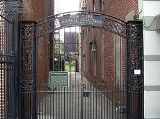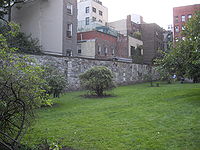
New York Marble Cemetery
Encyclopedia
The New York Marble Cemetery is an historic cemetery
founded in 1830, and located in the interior of the block bounded by East Second and 3rd Streets, Second Avenue
, and The Bowery, in the East Village
neighborhood of Manhattan
, New York City
. It is entered through an alleyway with an iron gate at each end, located between 41 and 43 Second Avenue. About 2,100 burials are recorded in the cemetery's written registers, most from prominent professional and merchant families in New York City.
The New York Marble Cemetery, which was New York City's first non-sectarian burial place, should not be confused with the nearby New York City Marble Cemetery
one block east, which is entirely separate, and was established one year later. Both cemeteries were designated New York City landmarks in 1969, and in 1980 both were added to the National Register of Historic Places
.
 The cemetery was founded as a commercial undertaking of Perkins Nichols and two partners, the lawyers Anthony Dey and George W. Strong. Recent outbreaks of yellow fever
The cemetery was founded as a commercial undertaking of Perkins Nichols and two partners, the lawyers Anthony Dey and George W. Strong. Recent outbreaks of yellow fever
led city residents to fear burying their dead in coffins just a few feet below ground, and public health legislation had outlawed earthen burials. Nichols, Dey and Strong intended to appeal to this market by providing underground vaults for burial.
Dey and Strong purchased the property, on what was then the northern edge of residential development, on July 13, 1830, and Nichols had the 156 underground family vaults, each the size of a small room, constructed from Tuckahoe marble and laid out in a grid of six columns by 26 rows. He was then reimbursed from the sale of the vaults.
Access to each pair of barrel vaults is by the removal of a stone slab set well below the grade of the lawn, which has no monuments or markers. Marble tablets mounted in the long north and south walls give the names of the original vault owners - though not the names of burials - and indicate the precise location of each corresponding underground vault. As of May 2011, parts of the north wall had collapsed, and other sections of it were reinforced with steel buttresses.
Nicols, Dey and Strong applied to the New York State Legislature for a special act of incorporation, and this was
granted on February 4, 1831. According to a historical plaque on the cemetery's entrance gate "Descendants of the 19th century owners may still be buried here."
Prominent New York uppertens families such as the Beekmans, Hones, Hoyts, Quackenbushes, Varicks and Van Zandts have vaults in the cemetery.
Cemetery
A cemetery is a place in which dead bodies and cremated remains are buried. The term "cemetery" implies that the land is specifically designated as a burying ground. Cemeteries in the Western world are where the final ceremonies of death are observed...
founded in 1830, and located in the interior of the block bounded by East Second and 3rd Streets, Second Avenue
Second Avenue (Manhattan)
Second Avenue is an avenue on the East Side of the New York City borough of Manhattan extending from Houston Street at its south end to the Harlem River Drive at 128th Street at its north end. A one-way street, vehicular traffic runs only downtown. A bicycle lane in the left hand portion from 55th...
, and The Bowery, in the East Village
East Village, Manhattan
The East Village is a neighborhood in the borough of Manhattan in New York City, lying east of Greenwich Village, south of Gramercy and Stuyvesant Town, and north of the Lower East Side...
neighborhood of Manhattan
Manhattan
Manhattan is the oldest and the most densely populated of the five boroughs of New York City. Located primarily on the island of Manhattan at the mouth of the Hudson River, the boundaries of the borough are identical to those of New York County, an original county of the state of New York...
, New York City
New York City
New York is the most populous city in the United States and the center of the New York Metropolitan Area, one of the most populous metropolitan areas in the world. New York exerts a significant impact upon global commerce, finance, media, art, fashion, research, technology, education, and...
. It is entered through an alleyway with an iron gate at each end, located between 41 and 43 Second Avenue. About 2,100 burials are recorded in the cemetery's written registers, most from prominent professional and merchant families in New York City.
The New York Marble Cemetery, which was New York City's first non-sectarian burial place, should not be confused with the nearby New York City Marble Cemetery
New York City Marble Cemetery
The New York City Marble Cemetery is an historic cemetery founded in 1831, and located at 52-74 East Second Street between First and Second Avenues in the East Village neighborhood of Manhattan, New York City...
one block east, which is entirely separate, and was established one year later. Both cemeteries were designated New York City landmarks in 1969, and in 1980 both were added to the National Register of Historic Places
National Register of Historic Places
The National Register of Historic Places is the United States government's official list of districts, sites, buildings, structures, and objects deemed worthy of preservation...
.
History and description

Yellow fever
Yellow fever is an acute viral hemorrhagic disease. The virus is a 40 to 50 nm enveloped RNA virus with positive sense of the Flaviviridae family....
led city residents to fear burying their dead in coffins just a few feet below ground, and public health legislation had outlawed earthen burials. Nichols, Dey and Strong intended to appeal to this market by providing underground vaults for burial.
Dey and Strong purchased the property, on what was then the northern edge of residential development, on July 13, 1830, and Nichols had the 156 underground family vaults, each the size of a small room, constructed from Tuckahoe marble and laid out in a grid of six columns by 26 rows. He was then reimbursed from the sale of the vaults.
Access to each pair of barrel vaults is by the removal of a stone slab set well below the grade of the lawn, which has no monuments or markers. Marble tablets mounted in the long north and south walls give the names of the original vault owners - though not the names of burials - and indicate the precise location of each corresponding underground vault. As of May 2011, parts of the north wall had collapsed, and other sections of it were reinforced with steel buttresses.
Nicols, Dey and Strong applied to the New York State Legislature for a special act of incorporation, and this was
granted on February 4, 1831. According to a historical plaque on the cemetery's entrance gate "Descendants of the 19th century owners may still be buried here."
Visiting
According to the cemetery's website, it is usually open on the fourth Sunday of the month from April to October, as well as on other weekends during the year.Notable burials
- Gurdon BuckGurdon BuckGurdon Buck was a pioneer military plastic surgeon during the Civil War. He's known for being the first doctor to incorporate pre and post-operative photographs into his publications...
, pioneer plastic surgeon - Aaron ClarkAaron ClarkAaron Clark was an American politician who became the second popularly elected Mayor of New York, serving two one-year terms from 1837 to 1839. He was a member of the Whig Party, the only member of his party to ever serve as mayor of New York.-Early life:Clark was born in Worthington, Massachusetts...
, Whig mayor of New York City from 1837-39 - Theodore GordonTheodore GordonTheodore Gordon, a consumptive hermit, was a writer who fished the Catskill region of New York State in the late 19th century through the early 20th century. He wrote articles for the Fishing Gazette from 1890 on and published works in Forest and Stream from 1903, sometimes under the pseudonym...
, angler and sage of the Neversink River - John Wheeler LeavittJohn Wheeler LeavittMy grandparents were both of Puritan New England stock, English entirely. Their ancestors had been early settlers in the northern and western part of Connecticut...
, prominent merchant, grandfather of artist Cecilia BeauxCecilia BeauxCecilia Beaux was an American society portraitist, in the manner of John Singer Sargent. She was a near contemporary of better-known American artist Mary Cassatt and also received her training in Philadelphia and France... - Stevens T. MasonStevens T. MasonStevens Thomson Mason , also known as Stevens T. Mason, Tom Mason, The Boy Governor, and lesser known nicknames Young Hotspur and The Stripling, was the territorial governor of the Michigan Territory, and later the first Governor of the state of Michigan. Mason guided the Michigan Territory into...
, first governor of Michigan, later reinterred in Capitol ParkCapitol Park Historic DistrictCapitol Park Historic District is a historic district located in Detroit, Michigan. It is roughly bounded by Grand River, Woodward and Michigan Avenues, and Washington Boulevard...
, Detroit - David Olyphant, a merchant involved in trade with China
- Luman ReedLuman ReedLuman Reed was a successful American merchant and an important patron of the arts. His support for the painters George Whiting Flagg and Thomas Cole were particularly significant contributions to the development of American painting during the early 19th century. He also commissioned works from...
American art patron - Uriah and Charles ScribnerCharles ScribnerCharles Scribner is the name of several members of a New York publishing family associated with Charles Scribner's Sons:*Charles Scribner I *Charles Scribner II *Charles Scribner III *Charles Scribner IV...
, publishers - James Tallmadge, Jr., Congressman (1817-19) and New York UniversityNew York UniversityNew York University is a private, nonsectarian research university based in New York City. NYU's main campus is situated in the Greenwich Village section of Manhattan...
President - Benjamin WrightBenjamin WrightBenjamin Wright was an American civil engineer who served as Chief Engineer of both the Erie Canal and Chesapeake and Ohio Canal. In 1969 he was declared the "Father of American Civil Engineering" by the American Society of Civil Engineers.Wright was born in Wethersfield, Connecticut to Ebenezer...
, Chief Engineer for the Erie CanalErie CanalThe Erie Canal is a waterway in New York that runs about from Albany, New York, on the Hudson River to Buffalo, New York, at Lake Erie, completing a navigable water route from the Atlantic Ocean to the Great Lakes. The canal contains 36 locks and encompasses a total elevation differential of...
Prominent New York uppertens families such as the Beekmans, Hones, Hoyts, Quackenbushes, Varicks and Van Zandts have vaults in the cemetery.
External links
- Official website
- New York Marble Cemetery, Second Ave at Find a GraveFind A GraveFind a Grave is a commercial website providing free access and input to an online database of cemetery records. It was founded in 1998 as a DBA and incorporated in 2000.-History:...
- Forgotten NY
- New-York Historical Society

